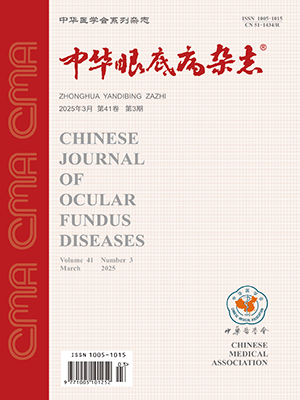| 1. |
Barber AJ, Lieth E, Khin SA, et al. Neural apoptosis in the retina during experimental and human diabetes. Early onset and effect of insulin[J]. J Clin Invest, 1998, 102(4): 783-791. DOI: 10.1172/JCI2425.
|
| 2. |
Araszkiewicz A, Zozulinska-Ziolkiewicz D. Retinal neurodegeneration in the course of diabetes-pathogenesis and clinical perspective[J]. Curr Neuropharmacol, 2016, 14(8): 805-809. DOI: 10.2174/1570159X14666160225154536.
|
| 3. |
Lee CS, Lee AY, Sim DA, et al. Reevaluating the definition of intraretinal microvascular abnormalities and neovascularization elsewhere in diabetic retinopathy using optical coherence tomography and fluorescein angiography[J]. Am J Ophthalmol, 2015, 159(1): 101-110. DOI: 10.1016/j.ajo.2014.09.041.
|
| 4. |
Hirano T, Kakihara S, Toriyama Y, et al. Wide-field en face swept-source optical coherence tomography angiography using extended field imaging in diabetic retinopathy[J]. Br J Ophthalmol, 2018, 102(9): 1199-1203. DOI: 10.1136/bjophthalmol-2017-311358.
|
| 5. |
Cao D, Yang D, Huang Z, et al. Optical coherence tomography angiography discerns preclinical diabetic retinopathy in eyes of patients with type 2 diabetes without clinical diabetic retinopathy[J]. Acta Diabetologica, 2018, 55(5): 469-477. DOI: 10.1007/s00592-018-1115-1.
|
| 6. |
Deng X, Li Z, Zeng P, et al. A diagnostic model for screening diabetic retinopathy using the hand-held electroretinogram device RETeval[J/OL]. Front Endocrinol (Lausanne), 2021, 12: 632457[2021-04-12]. https://pubmed.ncbi.nlm.nih.gov/33912134/. DOI: 10.3389/fendo.2021.632457.
|
| 7. |
Hou H, Moghimi S, Proudfoot JA, et al. Ganglion cell complex thickness and macular vessel density loss in primary open-angle glaucoma[J]. Ophthalmology, 2020, 127(8): 1043-1052. DOI: 10.1016/j.ophtha.2019.12.030.
|
| 8. |
van Dijk HW, Verbraak FD, Stehouwer M, et al. Association of visual function and ganglion cell layer thickness in patients with diabetes mellitus type 1 and no or minimal diabetic retinopathy[J]. Vision Res, 2011, 51(2): 224-228. DOI: 10.1016/j.visres.2010.08.024.
|
| 9. |
Değirmenci MFK, Demirel S, Batıoğlu F, et al. Role of a mydriasis-free, full-field flicker ERG device in the detection of diabetic retinopathy[J]. Doc Ophthalmol, 2018, 137(3): 131-141. DOI: 10.1007/s10633-018-9656-8.
|
| 10. |
Lee MW, Lee WH, Ryu CK, et al. Peripapillary retinal nerve fiber layer and microvasculature in prolonged type 2 diabetes patients without clinical diabetic retinopathy[J]. Invest Ophthalmol Vis Sci, 2021, 62(2): 9. DOI: 10.1167/iovs.62.2.9.
|
| 11. |
Fukuo M, Kondo M, Hirose A, et al. Screening for diabetic retinopathy using new mydriasis-free, full-field flicker ERG recording device[J/OL]. Sci Rep, 2016, 6: 36591[2016-11-08]. https://pubmed.ncbi.nlm.nih.gov/27824158/. DOI: 10.1038/srep36591.
|
| 12. |
Al-Otaibi H, Al-Otaibi MD, Khandekar R, et al. Validity, usefulness and cost of RETeval system for diabetic retinopathy screening[J]. Transl Vis Sci Technol, 2017, 6(3): 3. DOI: 10.1167/tvst.6.3.3.
|
| 13. |
Zeng Y, Cao D, Yu H, et al. Early retinal neurovascular impairment in patients with diabetes without clinically detectable retinopathy[J]. Br J Ophthalmol, 2019, 103(12): 1747-1752. DOI: 10.1136/bjophthalmol-2018-313582.
|




